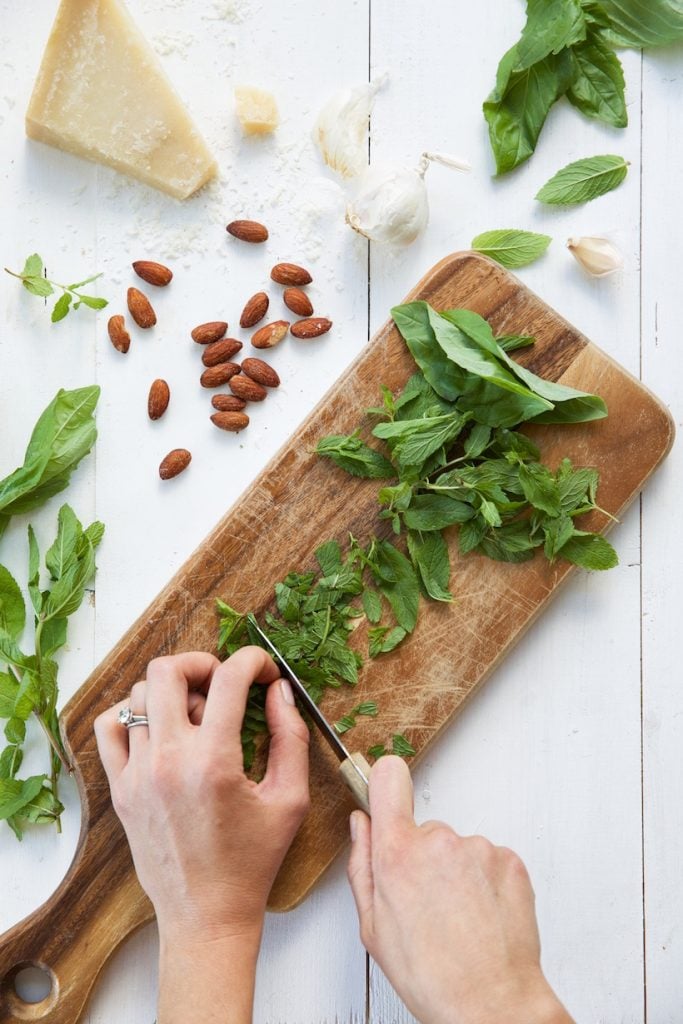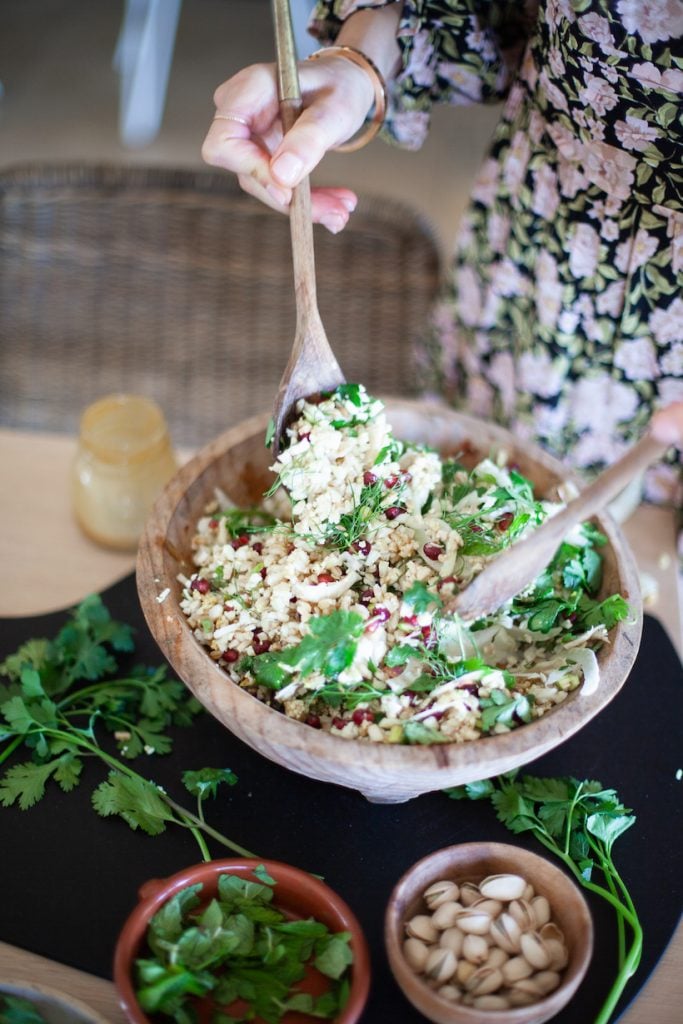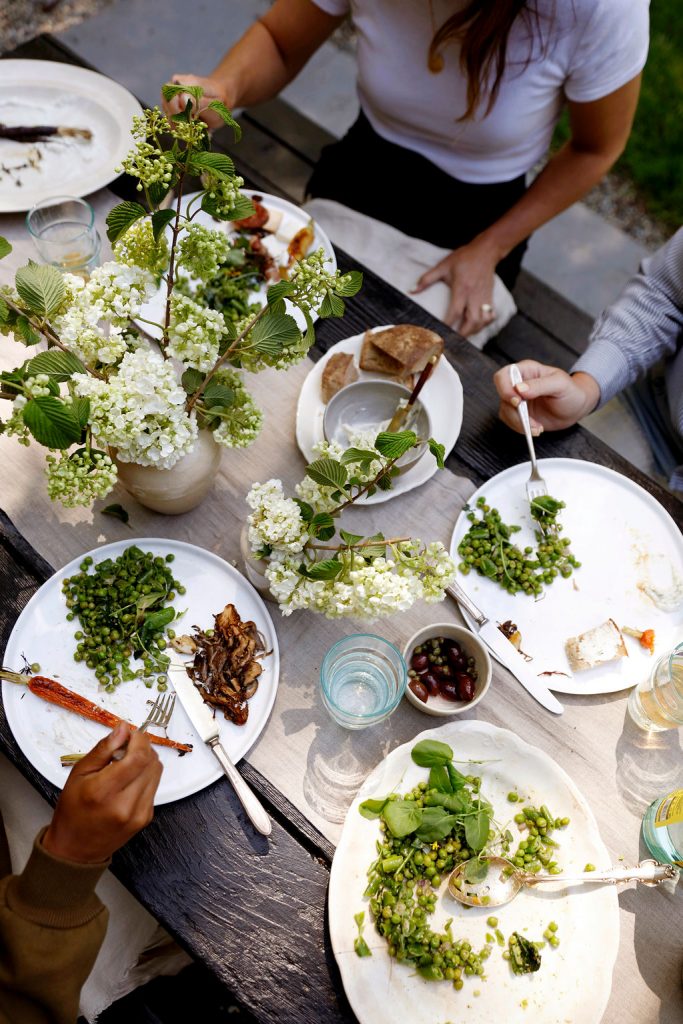Whether you grew them in your garden or bought them at the store, fresh herbs are the gift that keeps on giving. With little effort, they add flavor to anything you’re cooking—from grain bowls and pastas to dressings and dips. They’re particularly forgiving and equally versatile. Here at CS, a bouquet of fresh herbs is practically our love language. But herbs, particularly the tender green ones, are quite fragile. Due to storage (or forgetfulness), we’ve all wound up with slimy cilantro. This is unappetizing, a waste of money, and foregone produce! The good news? There are a variety of ways to store fresh herbs so they last longer. Even better news—they hold up very well in the freezer. That way, you can always have your go-to herb on hand. Get the most out of these flavor-packed, nutritious beauts by learning how to keep your herbs fresh in the fridge.
Feature image by Michelle Nash.



Different Types of Herbs
Before you store your herbs, know what you’re working with. To begin, simply look at your herbs. If the stems are tender and green, they’re going to fall into the “tender herbs” category. Some common varieties include basil, parsley, dill, tarragon, and cilantro. These are considered annual herbs and need to be planted each spring. These won’t survive a harsh Colorado winter, for example (I know it well). If your herbs have a woodier stem—one you wouldn’t want to eat raw—those count as woody herbs. These are herbs like chives, mint, rosemary, thyme, and sage. Unlike annual herbs, woodier herbs are perennials. They don’t need to be replanted every year. Armed with this knowledge, you’ll be better equipped to know how to keep your herbs fresh in the fridge.
Herbs are Functional Foods
Small but mighty, herbs are both delicious and nutritious. They’re functional foods rich in antioxidants, vitamins, and minerals to help boost the immune system. Specifically, research shows that consuming herbs may help to prevent and manage heart disease, cancer and diabetes. Eating herbs may also help to reduce blood clots and provide anti-inflammatory and anti-tumor properties. Below are common herbs and their health benefits.


Basil
Did you know that there are over 60 varieties of basil? Sweet basil is most widely used. Basil contains many vitamins and minerals, as well as antioxidants. Keep in mind that many of its health benefits disappear during the drying process, so opt for fresh basil whenever possible. Use basil in your favorite pasta dish—hot or cold!
Cilantro
Cilantro is known as an incredible detoxifier. Research shows that it can help protect against food poisoning, settle digestive upset, lower blood sugar levels, rid the body of heavy metals, and more. Furthermore, its antioxidants are thought to help reduce inflammation in the body and even help skin aging. We love cilantro on any kind of taco!
Parsley
Bright green in color, the two most common types are French curly-leaf parsley and Italian flat-leaf parsley. Both are packed with health benefits. Parsley is known to support bone health, eye health, heart health, and it has antibacterial properties. Cauliflower tabbouleh, anyone?
Mint
Mint leaves, like other herbs, are powerful antioxidants. They help relieve digestion, improve eye health, and support the body’s immune system. Mint leaves are rich in phosphorus, calcium and vitamins like C, D, E and A which improve the body’s immune system. This pea and mint salad is an ode to all the herb’s goodness and a beautiful nod to spring flavors.
Sage
Sage has a strong aroma and earthy flavor, which is why it’s typically used in small amounts. Even so, it’s packed with a variety of important nutrients and compounds. Sage is also used as a natural cleaning agent, pesticide, and ritual object in spiritual sage burning or smudging. This green herb is available fresh, dried, or in oil form and is high in vitamin K. These honey roasted carrots with sage are a weekly staple.


Chives
Chives are extremely rich in antioxidants, which contribute to most of their benefits. These antioxidants help fight cancer, improve heart health, and can even fight inflammation. They also detoxify the body and boost skin health. Plus, their fiber can ease the digestive process. Add these DIY dumplings—with chives!—to your next girls’ night.
Rosemary
Last but not least, rosemary. Rosemary is also high in antioxidants and anti-inflammatory compounds. These are thought to boost the immune system and improve blood circulation. Rosemary is considered a cognitive stimulant and can help improve memory performance and quality. It is also known to boost alertness, intelligence, and focus. Try this pasta with fresh rosemary.


Why It’s Important to Properly Store Herbs
This goes without saying, but taking a little extra time to properly store your herbs is a game-changer. It won’t ensure you never throw out another bunch of limp herbs, but it will help extend their shelf-life. Despite the annoyance of tackling a few mini-chores after grocery shopping, your future self will thank you. For long-lasting produce, say sayonara to shoving ingredients into shelves and drawers. In the long run, it will save you money, improve your health, reduce food waste, and make those organic herbs worth the price tag. Below are tips for how to keep your herbs fresh in the fridge.
Should You Wash Your Herbs Before Refrigerating Them?
Yes! Regardless of which type of herb you’ve purchased (or grown), you want to wash and dry them well. It’s a good policy to do this as soon as you return from the store. After all, an herb’s longevity is cut short by surface bacteria and dirt. Washing them does the trick. Run your herbs under cold water, then remove any stray dirt that might be hiding. After, spread them out on a clean tea towel and pat them dry. You can also use a salad spinner. Get as much water off of them as you can.


How to Store Your Herbs—You Have Options!
It depends on when you plan to use them.
Within the next week or two…
If you’re using tender herbs soon, opt for the bouquet route. (More on that below.) Essentially, cut off the bottom of their stems, remove any wilted leaves, then put them in a water glass with an inch of water. Keep them in the fridge and change the water every few days. For hardier herbs you plan to use soon, wrap them in a damp paper towel, and then wrap that in plastic wrap (for an eco-friendly option, consider these beeswax wraps). You’ll create a snug herb burrito.
Within the next few months…
If you don’t plan to use your herbs within a week or two, consider the freezer. For hardy herbs, wrap them like you would for the fridge, but stash them in a resealable freezer bag. When you’re ready to use them, they should thaw easily. For tender herbs, you’ll also use the freezer. But, the method is slightly different. For basil, dill, cilantro, etc., use an ice cube tray. Blend your herbs with a few tablespoons of olive oil (or water), then pour the mixture into the ice cube trays to freeze. Voila! Your herbs will last in the freezer for several months.


Place Your Tender Herbs in a Glass Jar
According to Food & Wine, the best way to store tender herbs is to clip off the bottom of their stems, remove any wilted or brown leaves, and put them in a Mason jar with 1-2 inches of cold water. They should be in a loose bunch without the original rubber band or twist tie. Make sure the stem ends are submerged in water. If you want to go the extra mile, keep the tops of your herbs covered with an overturned bag. (For a visual, see here.) Place your bouquet anywhere in the fridge. I’ve found that the shelf attached to the fridge door works best—that way, they get some warm air flow. Replace the water every few days, as you would with a bouquet of flowers.
Roll Hardy Herbs in a Dry Towel
When they’re mostly dry, transfer your hardy herbs in a single layer to a dry paper towel or clean kitchen towel. Roll it lengthwise into a cylinder. Place that in a bag and stash it in the fridge, preferably in the crisper drawer. For the bag, use breathable, washable, reusable mesh bags. They’re great quality and eco-friendly.


How Long do Fresh Herbs Last?
Now that you know how to keep your fresh herbs in the fridge, here’s a quick rundown:
PARSLEY: Tender herb with a 3-week lifespan.
CILANTRO: Tender herb with a 3-week lifespan.
TARRAGON: Tender herb with a 3-week lifespan.
DILL: Tender herb with a 2-week lifespan.
MINT: Tender herb with a 3-week lifespan.
BASIL: Tender herb with a 2-week lifespan.
ROSEMARY: Hardy herb with a 3-week lifespan.
THYME: Hardy herb with a 2-week lifespan.
SAGE: Hardy herb with a 2-week lifespan.
CHIVES: Hardy herb with a 1-week lifespan.
What herb-saving tips do you rely on for keeping your green stems fresh?




